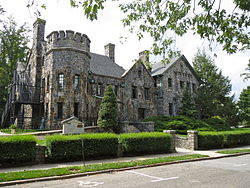Montford Area Historic District
|
Montford Area Historic District
|
|

Homewood School Building
|
|
| Location | Irregular pattern along Montford Ave., Asheville, North Carolina |
|---|---|
| Coordinates | 35°36′10″N 82°33′53″W / 35.60278°N 82.56472°WCoordinates: 35°36′10″N 82°33′53″W / 35.60278°N 82.56472°W |
| Built | 1848 |
| Architect | Smith,Richard Sharp; et al. |
| Architectural style | Queen Anne, Shingle Style, Colonial Revival;Bungalow |
| NRHP Reference # | |
| Added to NRHP | November 25, 1977 |
The Montford Area Historic District is a mainly residential neighborhood in Asheville, North Carolina that is included in the National Register of Historic Places.
According to the National Park Service the origin of the name Montford is unknown. In 1893 Montford was incorporated as an autonomous village to the north of Asheville. This was a tiny community of about 50 people, mainly local businessman and their families.
In 1889 the Asheville Loan, Construction, and Improvement Company, began to develop the neighborhood. The firm purchased and subdivided tracts of undeveloped land north of the Battery Park and sold lots. The enterprise languished until it was taken over by George Willis Pack, a lumber tycoon from the midwest who moved to Asheville in 1885. He is best known today as a philanthropist and benefactor of the Asheville Library and principal public square. He also donated land for Montford Park on the southern end of Montford Avenue.
In 1905 the village of Montford was annexed to the city, and though a few structures survived from the original village, Montford lost its autonomous identity. Today, Montford is bounded by U.S. Routes 19/23, I-240, and Broadway.
Most of the district's 600 buildings—primarily residences—were constructed between 1890 and 1920 . The people who bought lots and built in the Montford area in its building prime were for the most part middle class individuals who carried out the day-to-day activities of the city—businessman, lawyers, doctors, and a few architects. Several residents found immortality in Thomas Wolfe's autobiographical Look Homeward, Angel. Early city directories indicate a mixed population of working class citizens, and highly paid professionals, whites and blacks.
Though predominantly single family homes, land use in Montford has been mixed since the earliest days of development. The old Highland Hospital, located off the northern end of Montford Avenue, was the scene of a deadly fire in 1948, among the victims was Zelda Fitzgerald, wife of F. Scott Fitzgerald.
...
Wikipedia


